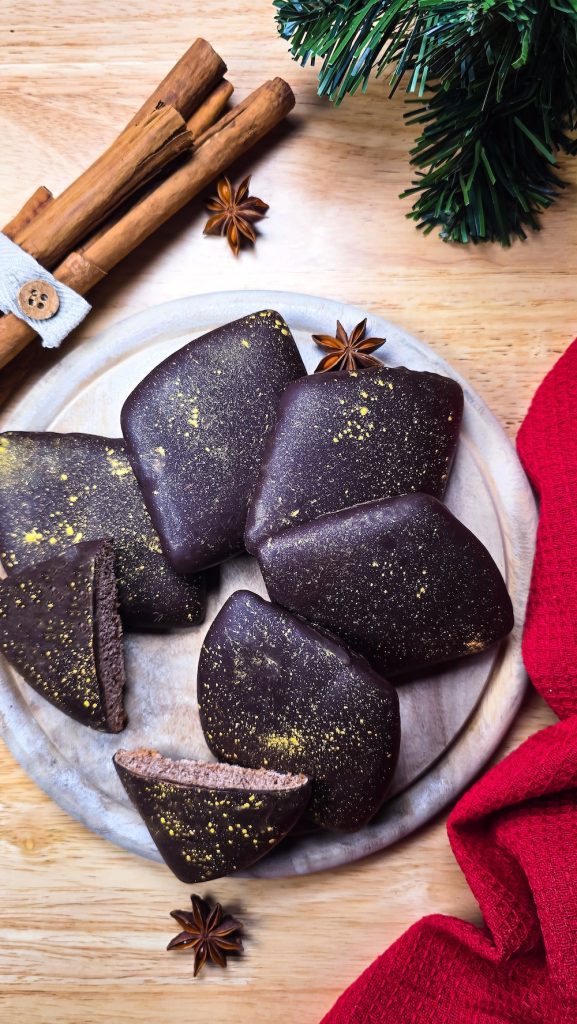There’s a time of year when the air fills with spicy aromas, childhood memories, and gestures passed down through generations: it’s Christmas, and with it, the return of mostaccioli—those little treasures of sweetness that carry centuries of history, art, and tradition.
In this article, I will take you on a romantic journey through the origins of this iconic sweet, its connection to Italian culture, and the influence it has even had in the arts. A discovery that begins in ancient Rome and arrives at the festive table, where simplicity turns into poetry.
The Origins of Mostaccioli: Wine, Honey, and Symbols of Prosperity
Mostaccioli trace their roots to the ancient mustaceum (an early Roman sweet made from flour and grape must), described by Cato the Elder in his De Agri Cultura. In the Roman countryside, these cakes flavored with bay leaves were served at wedding feasts, symbolizing fertility and abundance. Over the centuries, the sweet has been enriched with precious ingredients like honey, spices, and chocolate, transforming into the treat we know today. Each region has its own personal recipe: Neapolitan mostaccioli are soft and coated with dark chocolate, while in Calabria, they become edible works of art, hand-shaped and decorated with traditional motifs.
Between Cooking and Art: The Symbolic Value of Mostaccioli
The tradition of mostaccioli is not only culinary but also artistic. In Calabria, for example, pastry chefs used to make hard versions of this sweet in the shapes of hearts, animals, or symbolic figures, which were given to lovers or used as vows during religious festivals. Each shape told a story, and each decoration carried a message. Even in literature, mostaccioli have found their place: poets and writers have often cited them as symbols of sweetness and the warmth of Italian culture. Today, modern pastry art renews their spirit, transforming them into masterpieces to admire before tasting.
A Symbol of Italian Identity: Past and Present
There’s nothing more Italian than preparing mostaccioli at home during Advent, sharing the moment with family. This sweet, so simple yet so rich, tells the essence of our country: a love for traditions, respect for our roots, and the desire to turn food into an act of love. Even in Italian-American communities, mostaccioli are a symbol of belonging: a sweet that speaks of home, distant memories, and an identity to preserve. This personal version of mostaccioli with star anise and a golden dusting adds a touch of magic to the Christmas tradition, combining spicy flavors with an elegant and refined presentation.
Mostaccioli with Chocolate, Star Anise, and Golden Dust

Ingredients
- 3 1/3 cups all-purpose flour (500 g)
- 3/4 cup sugar (150 g)
- 1/2 cup honey (150 g)
- 1/4 cup unsweetened cocoa powder (50 g)
- 1 teaspoon cinnamon (1 tsp)
- 1 teaspoon nutmeg (1 tsp)
- 1/2 teaspoon ground cloves (1/2 tsp)
- 1/2 teaspoon ground star anise (1/2 tsp)
- 1 teaspoon baking soda (1 tsp)
- 3/4 cup lukewarm water (200 ml)
- 7 oz dark chocolate for coating (200 g)
- Edible golden dust for decoration (q.b.)
Method
- In a bowl, mix the flour, sugar, cocoa, spices (cinnamon, nutmeg, cloves, and star anise), and baking soda.
- Heat the honey with the lukewarm water, stirring until smooth. Gradually pour it over the dry ingredients and knead until a firm, uniform dough forms.
- On a lightly floured surface, roll out the dough to a thickness of about 1/2 inch (1 cm). Use a cookie cutter to cut diamond shapes.
- Place the mostaccioli on a baking sheet lined with parchment paper and bake in a preheated oven at 350°F (180°C) for about 15 minutes. Remove from the oven and let them cool completely.
- Melt the dark chocolate in a double boiler. Dip each mostacciolo into the chocolate one at a time, removing excess chocolate, and let them set on a wire rack.
- Before the chocolate hardens completely, dust each mostacciolo with a pinch of edible golden dust for a festive and elegant effect.

